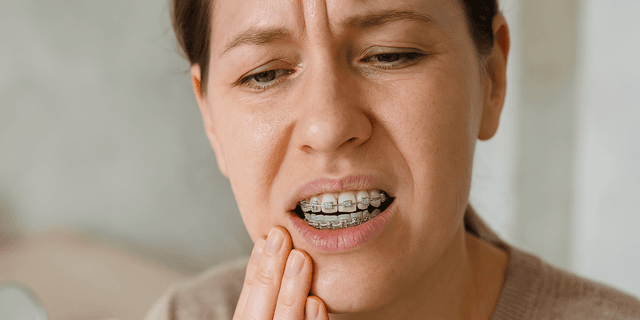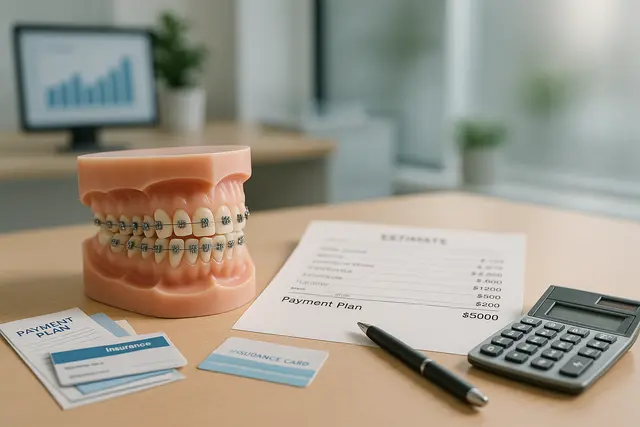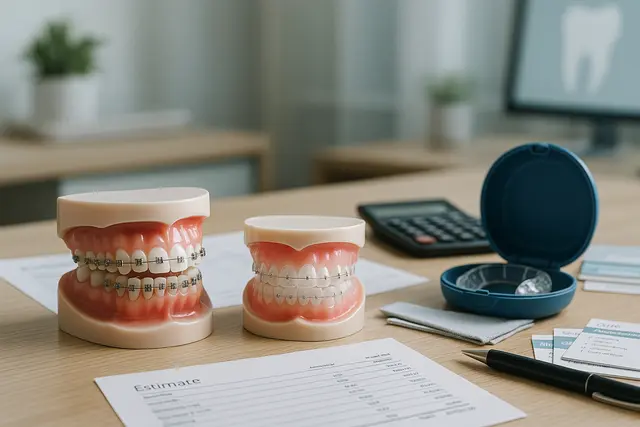Orthodontics
6 min read
Apr 03, 2025
Dealing with Emergencies: Common Braces Issues and Quick Fixes
Braces are built to be sturdy and reliable, but they’re not indestructible. Unexpected issues can happen, even with the best care. A loose bracket, a wire that pokes, or soreness after an adjustment can catch you off guard. These problems are common, but that doesn’t make them any less frustrating when they show up on a weekend or in the middle of the school day.

Loose or Broken Bracket
Brackets are the small metal or ceramic pieces bonded to your teeth that hold the archwire in place. Sometimes they detach, usually because of pressure from hard or sticky foods, or impact from sports or other accidents.
What should you do if a bracket comes loose?
First, check whether the bracket is still attached to the wire. If it is, don’t try to pull it off. Instead, leave it where it is, even if it moves slightly. Apply orthodontic wax to the bracket to prevent it from irritating your cheek or gum. This helps reduce soreness and protects soft tissue. Then, call your orthodontist to report the issue and arrange a repair. If the bracket has completely come off, rinse it with water (don’t soak it in anything), store it in a clean container, and bring it to your next appointment.
Does a loose bracket always hurt?
Not necessarily. Sometimes it just moves around without causing pain. But if it turns or slides along the wire, it may start to poke or scrape the inside of your mouth. Wax can help, but prolonged irritation or any signs of swelling merit a quicker consultation. Even if you’re not in pain, don’t wait until your next regular visit, loose brackets should be addressed promptly to prevent delays in treatment.
Poking Wires
Wire ends can become an issue between appointments. Whether from daily wear, a recent adjustment, or minor trauma, they may shift and start digging into the cheek or gum tissue. It’s a small problem at first, but left alone, it can make eating painful or cause a sore.
How can you stop a wire from poking your cheek?
First, try to move the wire gently. A cotton swab, pencil eraser, or clean fingertip can sometimes be used to push it back toward the bracket or under the arch where it’s less irritating. Orthodontic wax is your next line of defense, dry the area, then place a small ball of wax over the wire to create a smooth surface. That often buys enough time until you can be seen.
Can you cut a poking wire at home?
In some cases, yes, but only if it’s truly urgent. If wax and repositioning won’t help, and the wire keeps causing pain, you can use sterilized nail clippers or small wire cutters to snip the protruding end. Do it in front of a mirror, under good light, and take care not to damage nearby brackets. Clean the area and tools thoroughly beforehand. Then call your orthodontist to explain what happened and schedule a follow-up.
Wire Slipped Out of Bracket
This can happen when the wire gets bent or pulled during brushing, eating, or playing sports.
What if the wire slips out of the back bracket?
First, don’t panic. If the wire has slipped out of the last bracket or tube near the back of your mouth and isn't causing pain, it's usually not urgent but does require attention. Use clean tweezers to try gently guiding the wire back into place. Grip the wire close to the end and apply slow, steady pressure, don’t force it. If it won’t cooperate or keeps slipping out, cover the end with orthodontic wax to prevent irritation. Then call your orthodontist for instructions or an appointment.
Can the wire cause damage if left out too long?
Possibly. A loose wire can shift your teeth in unintended ways or cause soft-tissue irritation. If left for days, it may lead to treatment delays or cause mouth sores. While it’s not usually an emergency that requires immediate attention the same day, don’t ignore it. Contact the orthodontic office within a day or two to avoid setbacks.
Soreness or Irritation
Some soreness is part of the process, particularly after braces are first put on or adjusted. The pressure they apply to shift teeth can leave the mouth feeling tender for a few days. This irritation isn’t usually a cause for concern, but it can interfere with eating and speaking if not managed correctly.
What can ease braces pain at home?
Several basic measures help reduce discomfort. Rinsing with warm salt water can soothe sore spots in the mouth. Stick to soft foods like soups, yogurt, or pasta during periods of soreness. Over-the-counter pain relievers, used as directed, can help, especially in the first day or two following an adjustment. Wax remains the go-to option for brackets or wires that rub repeatedly.
Is it normal for your mouth to hurt after braces are tightened?
Yes. Mild to moderate soreness should be expected for up to three days after tightening. If the pain persists longer or worsens over time, that may indicate a problem with the appliance. In that case, call your orthodontist to rule out issues like a dislodged wire or bracket putting pressure in the wrong place.
Managing soreness is largely about patience and routine care. As your mouth adjusts, the discomfort typically fades.
Mouth Sores from Braces
Mouth sores are a common side effect of having braces. They’re usually caused by metal brackets or wires rubbing against the inside of your cheeks, lips, or tongue. These sores can be painful but aren't typically dangerous.
How do you treat sores caused by braces?
Start by identifying what’s causing the irritation, usually a sharp edge or a specific bracket. Apply orthodontic wax over the area to smooth out the contact point. Rinsing several times a day with warm salt water can help soothe the tissue and reduce inflammation. Avoid foods that could aggravate the sore further, things like citrus, chips, or anything spicy. If needed, use a topical oral gel to numb the area temporarily.
Do they go away on their own?
Yes. Most mouth sores heal within a few days, especially with proper care. If a sore doesn’t improve within a week or seems to be getting worse, it’s a good idea to check in with your orthodontist. Continued irritation in the same spot could mean that part of your braces needs to be adjusted.
What to Keep in an Orthodontic Emergency Kit
Minor issues with braces can become bigger problems if you’re not ready. Having the right tools on hand can make the difference between discomfort and staying in control until professional help is available.
Start with orthodontic wax. It’s the first line of defense against irritation from loose parts or sharp edges. Tweezers come next, helpful for repositioning a wire that’s popped out or adjusting something that’s shifted. In cases where a wire needs trimming and you can’t reach an office, sterilized nail clippers or wire cutters will do in a pinch. Cotton swabs help push wires or apply wax more precisely.
Keep salt available, warm rinses reduce inflammation and promote healing, especially after a wire poke or sore. Carrying over-the-counter pain relievers (like ibuprofen or acetaminophen) can keep soreness manageable, particularly after adjustments or when a wire causes unexpected pressure.
Finally, include a small, clean container. If a bracket detaches completely, securing it safely until your next appointment keeps it from getting lost, or swallowed.
Keep this kit at home and consider a smaller version for school or travel. Emergencies don’t wait for a good time. Being prepared limits the disruption.
When to Call the Orthodontist
Most minor braces issues can wait a few days, but others need attention sooner. If something breaks, a bracket, a band, or a wire, it’s worth calling your orthodontist, even if you're not in pain. Broken appliances can affect how your teeth move and may delay your treatment.
You should also call if you experience sharp pain that doesn’t respond to home remedies, bleeding that won’t stop, or swelling in your mouth or gums. These could be signs of something more serious, like an infection or an injury to the soft tissue.
Another reason to get in touch: if you’ve tried a home fix and it doesn't work, or you’re not sure what to do. The office staff can tell you whether it can wait or if they need to see you sooner.
When in doubt, make the call. It’s better to ask than risk prolonging your treatment, or making the problem worse.
What Should You Do If a Bracket Comes Loose?
If a bracket detaches but remains on the wire, don’t remove it. Use orthodontic wax to keep it from irritating your mouth and call your orthodontist to schedule a repair. If it falls off completely, store it in a clean container and bring it to your next visit.
How Can You Manage a Wire That’s Poking Your Cheek?
Try gently pushing the wire back into place using a cotton swab or pencil eraser. If that doesn’t work, cover the end with orthodontic wax to prevent irritation. In urgent cases, you can carefully trim the wire with sterilized nail clippers, then contact your orthodontist for guidance.
What Helps Relieve Soreness From Braces at Home?
Rinse your mouth with warm salt water, stick to soft foods, and use over-the-counter pain relievers as directed. Orthodontic wax can reduce irritation from brackets or wires. Discomfort usually subsides within a few days after adjustments.
When Should You Call Your Orthodontist About a Problem?
Reach out if a bracket or wire breaks, a wire is causing persistent pain, or a sore isn’t healing. Also call if you’re unsure how to manage an issue or if swelling or bleeding occurs. Early intervention can prevent delays and avoid complications in your treatment.
Read Next
Related Posts

Orthodontics
How Much Are Metal Braces? Cost Comparison With Other Options
Thinking about getting braces but overwhelmed by the cost? You’re not alone. Orthodontic treatment can be a major investment, and understanding the different price points, from metal braces to clear aligners, can help you make a smart, confident decision.
5 min read
Sep 15, 2025

Orthodontics
Retainer That Looks like Braces: Benefits for Long-Term Alignment
A retainer might not get as much attention as braces, but it plays a crucial role in maintaining your smile after orthodontic treatment. Whether you're new to retainers or curious about the type that looks like braces, understanding their purpose and benefits is key to keeping your teeth aligned for the long haul.
6 min read
Sep 15, 2025

Orthodontics
Orthodontics & Braces Statistics (Adults + Kids)
Orthodontics has transformed from a niche medical service for teenagers into a booming sector that spans all ages. Today, both adults and children seek orthodontic treatment to improve their smiles, fix bite issues, and boost self-confidence.
4 min read
Aug 21, 2025
Don’t have time to research every dentist around you?
See why 30k+ patients trusted us